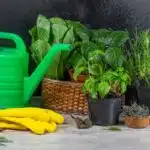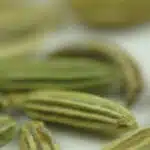Parsley is an incredibly versatile herb, prized for its culinary and medicinal uses as well as its ornamental value in the garden. Not only can it be used to add flavor to a variety of dishes, but it has a number of health benefits as well. It’s easy to grow parsley from either seeds or cuttings, making it a great choice for even the most novice gardener. For those looking to add this flavorful herb to their garden, here are some tips on how to get started.
Growing parsley is not complicated and requires little effort on the part of the gardener. It grows best in full sun, although it will tolerate partial shade. It prefers moist soils with plenty of organic matter and a pH level between 6.5 and 7.5. The key to success when growing parsley is regular watering and fertilizing during the growing season so that the soil stays evenly moist.
Parsley can be started from either seed or cuttings, with both methods having advantages and disadvantages depending on individual needs and preferences. Starting from seed allows you to have greater control over the growth of your plants, while starting from cuttings gives you more immediate gratification since your plants will start producing leaves right away. Regardless of which route you take, proper care and maintenance are essential for success when growing parsley in your garden!
Benefits Of Growing Parsley
Let’s get to the root of growing parsley. Believe it or not, this seemingly ordinary herb packs a powerful punch in terms of its health benefits and culinary possibilities! While parsley may seem like an afterthought in the world of herbs, this veggie is actually quite versatile. In fact, with a little love and attention, you can master the art of growing parsley in your own garden.
First off, let’s explore some of the advantages that come from growing parsley at home. For starters, it’s packed with Vitamin C and other antioxidants that are essential for good health. Parsley also has anti-inflammatory properties that help relieve joint pain. Plus, growing your own parsley means you don’t have to worry about any potential toxins found in store-bought varieties. Additionally, homegrown parsley will be more flavorful than store-bought varieties since it hasn’t been shipped long distances or stored for extended periods of time.
Not only does parsley bring a wealth of health benefits, but it can also be used as a garnish or as part of recipes such as soups, salads and sauces. It adds flavor and texture to dishes without overpowering them – all while adding color and freshness to your meals! So if you’re looking for an easy yet delicious way to add something special to your menu, look no further than growing parsley in your garden!
By now it should be evident why growing parsley is such a great idea – not just for chefs but for anyone looking to reap the many rewards this herb has to offer! Armed with this knowledge we can now move on to discuss the different varieties available…
Parsley Varieties
Varieties of parsley can be likened to a magic box full of wonders for the gardening enthusiast. With its vibrant green hue and strong, earthy scent, it’s no wonder why this herb is so beloved. From curly to flat-leafed types, there are several varieties of parsley that can elevate your garden:
Curly Leaf Parsley – These lush, feathery fronds have a slightly sweet and peppery taste that adds a zing to salads, soups and stews.
Flat Leaf Parsley – Known as Italian parsley, this variety has a stronger flavor than curly leaf and is ideal for use in recipes where the herb stands out as an ingredient.
Hamburg Root Parsley – This heirloom variety produces large roots that are prized in European cuisine for making stocks and sauces.
Moss curled parsley – This is an attractive ornamental variety with flavorful leaves and a mild scent of celery.
Japanese Parsley– A popular Asian vegetable with long stems and tender leaves that can be stir-fried or used raw in salads or soups.
Each type of parsley offers unique characteristics and flavors that make them all distinctive in their own way—so it’s important to do some research before deciding which one will thrive best in your garden. Knowing your local climate conditions, soil quality, water availability, sunlight exposure and other factors will help you select the right type to grow successfully at home. So let the adventure begin!
Choosing A Location For Parsley
Choosing the right location for parsley is like finding your way through a labyrinth – complicated, yet rewarding. As a botanist and gardener, I take great pride in helping others choose the best spot for this herb to thrive.
Parsley loves sun, but it can also handle some shade. It does best when grown in a moist area with good drainage. When deciding on a spot for parsley, consider how much sun and water the area gets throughout the day. If it’s too wet or too dry, the herb may not grow as well. Also keep in mind that parsley needs room to spread out; it will become stunted if overcrowded with other plants.
When selecting an ideal location, remember that parsley is a cool-weather crop and can be planted outdoors in spring or fall. It should be placed away from strong winds which could damage its delicate leaves and stems. With these simple tips, you’ll be able to find an ideal spot for your parsley plant so you can enjoy its fresh flavor year round!
Preparing The Soil For Parsley
What is the best way to ensure that your parsley grows well? Preparing the soil!
As a specialist in botany and gardening, I can assure you that preparing the soil is integral to successful parsley growth. But what exactly does this entail?
Good soil preparation requires first removing any weeds from the area, followed by adding organic matter such as compost or aged manure. This will help with water retention and nutrient availability for your parsley plants. Additionally, it is important to loosen the top few inches of soil for efficient root growth. Once this is done, you should also add some slow-release fertilizer to give your plants an additional boost.
By following these steps, you will be setting up your parsley for success! Now that we have prepared the soil, let’s move on to planting the parsley seeds…
Planting Parsley Seeds
Planting parsley seeds is an intricate art, one that requires patient hands and a gentle touch. As with any horticultural endeavor, the process of planting must be done correctly and with careful consideration. Allusion to the alchemists of old, who sought to transform lead into gold, is apt; for this is exactly what gardeners set out to do with their parsley seed, turning it into a vibrant bed of verdant foliage.
The first step in planting parsley seed is to prepare the soil. The soil should be light and nutrient-rich, free from stones or other debris that may impede growth. Once the soil has been amended accordingly, it’s time to sow the seed. To do this effectively, dig holes about 1/4 inch deep and place two or three seeds in each hole, then lightly cover them with soil. A good rule of thumb is to space out the holes about 10 inches apart for a larger harvest later on.
For best results when growing parsley from seed, keep the soil moist but not sodden throughout germination and establishment of young plants. With its water-loving nature and preference for full sunlight (ideally 6–8 hours per day), keeping up with watering will help ensure a healthy harvest come harvest time!
Caring For Parsley Plants
Once parsley seeds have been planted, proper care is essential for the successful growth of this flavorful herb. As a specialist in botany and gardening, I can assure you that with a few simple steps, your parsley plants will be flourishing in no time.
First and foremost, parsley requires plenty of sunlight to thrive. Aim to give the plants at least five hours of sunlight per day, more if possible. Additionally, parsley grows best in well-draining soil with a neutral pH level. It’s important to monitor the soil for signs of drainage issues or nutrient deficiencies. If necessary, amend the soil with compost or other organic matter to improve drainage and fertility.
Parsley also needs consistent watering to stay healthy and productive. Depending on where you live, it may be necessary to supplement natural rainfall with additional irrigation. Be careful not to over water though; too much moisture can cause root rot and encourage fungal diseases so make sure your soil is adequately drained before applying more water.
In order for your parsley plants to really take off, it’s important to pay attention to these basic care tips. With some attention and dedication, your parsley should be producing plenty of delicious leaves for salads, soups and more! Now let’s move on to how often you should water them…
Watering Parsley Plants
As the old adage goes, “you reap what you sow”, and this is especially true when it comes to growing parsley. With proper knowledge and care, gardeners can successfully grow this fragrant herb in their gardens. When it comes to watering parsley plants, there are a few key pieces of information that any botanist or gardener should know.
When watering parsley plants, it is important to ensure the soil is moist but not soggy. As soon as the top 1-2 inches of soil begins to dry out, lightly water your parsley plants until water puddles in the saucer below them. During periods of extreme heat or drought, more frequent watering may be necessary. It is also important that you avoid overhead watering by using a soaker hose or drip irrigation system instead. This will help to reduce the risk of fungal diseases developing on your plants due to excess moisture on foliage and stems.
Additionally, mulching around your parsley plants can help conserve moisture and keep weeds at bay. A layer of organic mulch such as compost or shredded leaves will also add essential nutrients to the soil as it breaks down over time. By following these tips for successful watering of parsley, gardeners can be sure their crop will thrive with minimal effort! Moving forward in caring for parsley plants means understanding how to feed them properly…
Feeding Parsley Plants
When it comes to growing parsley, feeding the plants is an important part of the process. Parsley grows best in soil that is high in nitrogen and potassium, so adding a balanced fertilizer with these essential nutrients is necessary for healthy growth. Additionally, foliar feeding can also be beneficial as it allows the plant to absorb the nutrients more quickly.
It’s important to remember not to over-fertilize as this can lead to an accumulation of salts in the soil which can cause stunted growth and reduced yields. When using a fertilizer, always follow the instructions on the packet and apply only what is recommended per square foot or metre of soil. For foliar feeding, use a liquid fertilizer diluted down to half strength and spray onto both sides of the leaves twice per month during active growth periods.
Finally, mulching around parsley plants helps maintain regular watering levels and keeps weeds at bay. Organic matter such as compost, grass clippings or straw applied two inches thick will do the trick nicely. This helps keep moisture in and provides additional nutrition too as it breaks down slowly into the soil. With careful fertilization and mulching practices, your parsley plants will be well on their way towards success!
Controlling Pests And Diseases
Pest and disease control is an important aspect of growing parsley. It is important to identify any issues early to prevent them from spreading and causing severe damage to the plant. To ensure a healthy crop, it’s essential to regularly examine plants for signs of pests or diseases. Inspect the leaves and stems for small insects, yellowing foliage, or fungal growths.
To keep pests under control, use natural methods like introducing beneficial predatory insects like ladybugs or lacewings into the garden. You can also try horticultural oils or insecticidal soaps as a way to repel pests organically. If you find that your plants have been infected with disease, removing affected leaves and debris will help stop it from spreading further.
When it comes to controlling diseases, there are a few steps you can take such as avoiding overcrowding plants and making sure they get enough air circulation between them. Also make sure the soil has good drainage in order to reduce the risk of fungal infections. Additionally, avoid wetting foliage when watering as this can create ideal conditions for fungal growth. Taking these steps should help keep your parsley healthy and free from most pest and disease problems. With a bit of care and attention, you’ll be able to enjoy a bountiful harvest of fresh parsley soon!
Harvesting Parsley
Harvesting parsley is like a treasure hunt. It’s hidden beneath the foliage and waiting to be unearthed. As a specialist in botany and gardening, I can tell you that harvesting this herb is an art that needs to be mastered.
The first step is to identify when your parsley plants are ready for harvest. You’ll know they’re ready when their leaves have developed vibrant colors and their stems start to branch out. The best time to do this is just before the plant flowers—that way you get the most flavor from the leaves. Once you’ve identified which plants are mature enough, it’s time to actually harvest them.
Using a pair of scissors or garden shears, carefully snip off the stems about half an inch above where they branch out from the main stem. This will help promote new growth and ensure that your parsley continues producing leaves for future harvests. After harvesting, it’s important to store your parsley correctly in order to maintain its flavor and shelf life…
Storing Parsley
Once you have harvested your parsley, it is important to store it correctly. Proper storage will ensure that you can enjoy its flavor and nutrition for weeks or even months. Here are three key steps to properly storing parsley:
Firstly, wrap the stems of each bunch with a damp paper towel and store them in an airtight container in the refrigerator. This will help keep the leaves crisp and prevent wilting. Be sure to replace the damp paper towel every two days to keep the parsley fresh.
Secondly, if you want to freeze your parsley, blanch it first by submerging it into boiling water for 1-2 minutes before removing it and placing it in an ice bath. Once cooled, pat dry with a paper towel and place into zipper freezer bags before placing them in the freezer. These tips will help preserve the flavor and texture of your parsley even after freezing.
Finally, if you plan on using dried parsley for recipes such as soups or stews, simply bundle several stems together and hang them upside down in a warm, dry location such as a pantry or cupboard away from direct sunlight or heat sources until they are fully dried (generally around one week). Once dry, crumble the leaves off of the stems before storing them in an airtight container or bag for future use.
Storing your freshly harvested parsley correctly will ensure that its vibrant flavors can be enjoyed whenever desired!
Using Parsley
Thriving with parsley is as easy as pie – so why not give it a go? Parsley, an herb that grows well in both gardens and containers, can add a tasty and nutritious element to your cooking. In this article, we’ll cover the basics of using parsley once it’s harvested.
For any aspiring gardening specialists out there, knowing how to use parsley is key for making the most of your harvest. Before you start cooking with it, you must first select the best specimens – look for leaves that are bright green in color and do not have any wilting or browning edges. Once you’ve got suitable parsley, you can move on to creating delicious dishes!
The flavors of parsley are unmistakable – its distinct flavor offers a light and sweet taste that pairs nicely with many dishes. Whether you’re adding some freshness to fish tacos or enhancing the flavor of a creamy risotto, you can rely on parsley to add just the right amount of zest. Plus, when diced finely, it makes a great garnish on top of salads or soups too. Freshly harvested parsley will last up to one week in the refrigerator if stored properly wrapped in damp paper towels or stored in airtight containers.
With these tips in mind, your garden-fresh parsley should be bursting with flavor and ready to take center-stage at your next mealtime! Now let’s explore companion planting with parsley for even greater success!
Companion Planting With Parsley
Companion planting can be a great way to get the most out of parsley when gardening. By strategically placing certain plants in your garden, you can help boost growth and reduce pests. Here are five key tips to consider when planting parsley alongside other vegetables:
Parsley is known to attract beneficial insects like ladybugs, lacewings, and hoverflies which helps keep bad bugs away from your other plants.
Planting parsley near asparagus can increase its flavor and help protect against asparagus beetles.
Parsley can repel some pests such as aphids, spider mites, carrot flies, and cabbage loopers when planted near susceptible crops such as carrots or cabbages.
Parsley does best when planted with onions, tomatoes or peppers as it helps each of these plants grow better with the presence of the herb plant’s strong aroma.
When planting parsley near mint, it helps keep the mint from taking over in your garden plot by providing a barrier for its growth and keeping it contained to one area of the plot.
As any botanist or horticulturalist will tell you, companion planting with parsley is an effective way to maximize both yields and flavor while protecting vulnerable vegetables from attack by pests or disease-carrying organisms. Taking into consideration how different plants interact with one another will ensure successful harvests season after season! With this knowledge on hand, let’s move onto addressing common parsley questions…
Common Parsley Questions
When it comes to growing parsley, there are few plants that can rival its complexity and beauty. From its nutrient-rich leaves to its fragrant scent, this plant is truly a marvel of gardening. But when it comes to cultivation, common questions always arise: how often should I water? What’s the best soil type? Which pests might I encounter? Here are some answers that will help you grow parsley like a pro:
• Watering: Parsley needs about an inch of water per week to thrive, so make sure you keep your soil moist without over-watering. • Soil Type: Parsley prefers rich, well-drained soil with plenty of organic matter. Compost or aged manure can be added for extra nutrients. • Pests: Aphids, spider mites, and leaf miners are all potential pests of parsley. To get rid of them, use insecticidal soap or a homemade garlic spray solution.
In addition to these basics, companion planting is also important for successful parsley growth. Planting it alongside chives, onions, tomatoes, and other herbs can help repel pests and increase yields. With the right care and attention your parsley will be flourishing in no time! Transitioning into troubleshooting parsley problems is essential to ensure success in every gardening project.
Troubleshooting Parsley Problems
Coincidence has it, that as soon as one starts to grow parsley, troubleshooting problems may suddenly appear. As a specialist in botany and gardening, I’m here to tell you that tackling these issues doesn’t need to be difficult. In this article, we’ll look at the 15th common parsley question: troubleshooting parsley problems.
When growing parsley, it’s important to note any issues associated with diseases or pests. Wilting leaves can indicate an insect infestation or disease; if left untreated, these can cause serious damage and even kill your plant. It’s also important to check for any nutrient deficiencies – yellow leaves could be a sign of inadequate nitrogen levels or too much potassium. Another issue might be incorrect soil pH – if the pH is too high or low, the plant won’t absorb nutrients properly and will suffer from stunted growth.
The best way to tackle any of these problems is to diagnose the exact cause before attempting treatment. This can be done by examining the plant closely for signs of infection or pest damage and testing the soil for nutrient levels and pH balance. Once you have determined what is causing the problem, you can then begin treating it accordingly – whether that’s adding more fertilizer or using a pesticide spray.
By being proactive with potential issues, you should have no trouble successfully growing parsley in your garden!
Frequently Asked Questions
What Are The Best Types Of Parsley To Grow In A Pot?
Growing parsley in a pot is like putting a puzzle together – you need to find the right pieces, and fit them all together perfectly. For those who are looking to get into growing this aromatic herb, selecting the best types of parsley for potting is key. As a specialist in botany and gardening, I’d like to share my insights on this matter with you.
When it comes to parsley varieties for pots, there are two main types: curly-leafed or flat-leafed. Curly-leafed parsley has small, tightly coiled leaves that have a mild flavor. Flat-leafed parsley has larger leaves and a more robust flavor that some people prefer. Both types can be grown in pots as long as they receive enough sunlight and water.
When it comes to caring for your potted parsley plants, there are a few tips that can help ensure successful growth. The soil should be well drained and kept moist but not soggy. Potted plants benefit from regular fertilization with an organic fertilizer such as compost or fish emulsion. Finally, make sure to prune the plants regularly to keep them healthy and encourage new growth.
By following these simple steps, your potted parsley plants will thrive and provide you with fresh herbs all year round! With patience and dedication, anyone can become an expert at growing parsley in containers – just remember the key elements: choose the right variety for you, provide proper drainage, give adequate sunlight and water regularly, fertilize periodically, and prune often!
How Often Should I Water Parsley Plants?
Watering parsley plants is like dancing a delicate ballet; the timing, intensity and frequency should be carefully judged in order to achieve optimal growth. As an expert botanist and gardener, I can tell you that parsley plants need to be watered regularly for best results.
Parsley should be watered lightly every day during its growing season, typically from spring through summer. The amount of water needed will depend on the climate and soil conditions, but most gardeners recommend about 1/4 inch of water per day. If you are growing parsley in a container, check the soil every other day to make sure it’s evenly moist but not soggy.
In order to help your parsley thrive, make sure it gets plenty of sun while also providing a consistent level of moisture. To ensure this balance is achieved, use a soaker hose or drip irrigation system near the plant’s base. This will help you keep the soil moist without over-watering or leaving it too dry. Additionally, mulching around the plant may help retain moisture and reduce weeds that compete with the parsley for nutrients.
By following these simple steps, you’ll be well on your way to having healthy, lush parsley plants all season long!
Can I Grow Parsley Indoors?
Can I grow parsley indoors? The answer is yes, and it is a great choice for those looking to add a fresh herb to their kitchen. Growing parsley indoors has become increasingly popular in recent years due to its versatility and its ability to thrive in the right environment. With that being said, there are a few things one should be mindful of when cultivating parsley indoors.
Picture this: You come home after a long day of work and you can smell the aroma of freshly picked herbs wafting through your kitchen. This is what could happen if you learn how to grow parsley indoors correctly. It’s easy to do, but there are some key steps that need to be taken if you want your plants to thrive.
First, it’s important to provide your parsley with plenty of sunlight: ideally around five hours per day. If you’re unable to give your plants that much light, consider using artificial lighting such as grow lights or fluorescent bulbs. Additionally, keep in mind that parsley grows best in temperatures between 60-70°F (15-21°C).
Next, make sure that the soil you use drains well so that your plants don’t become waterlogged and rot away. You’ll also want to fertilize every two weeks during the growing season with an all-purpose fertilizer or one specifically formulated for herbs like parsley. Finally, water regularly but don’t overdo it; too much water can drown the roots and cause the plant’s leaves to wilt.
By following these simple guidelines, you can ensure that your indoor parsley plants will stay healthy and productive throughout their growing season – providing you with delicious herbs for months on end!
Is Parsley Suitable For Hydroponic Gardening?
Growing parsley is like painting a masterpiece – it requires skill, patience, and a deep understanding of the plant’s needs. Hydroponics is an interesting alternative to traditional planting methods and has its own set of challenges. So, is parsley suitable for hydroponic gardening?
The answer is yes – but with certain caveats. Parsley grows best in a moist environment that has plenty of oxygenation and light. In a hydroponic system, this can be achieved by using nutrient-rich water and carefully controlling the pH balance. Additionally, because hydroponic systems are usually quite shallow, it’s important to ensure that your plants are getting adequate amounts of light and air circulation to help them grow strong and healthy.
Finally, when growing parsley in a hydroponic system you must take extra care when harvesting the leaves – since they’re delicate and prone to wilting quickly if not handled correctly. However, if you follow all the necessary steps for successful hydroponic gardening, you’ll find that growing parsley this way can be very rewarding! With proper care and attention, you’ll be able to enjoy fresh parsley year-round.
What Are The Best Companion Plants To Grow With Parsley?
Parsley is like a heart of gold, it will bring life and texture to any garden. Growing companion plants alongside it can give your garden the added sparkle of a perfect summer evening. Here are three of the best options to accompany parsley in your garden:
Tomatoes – Tomatoes and parsley are a classic combination, as each plant has different nutrient requirements but they both prefer full sun and well-draining soil conditions. Tomatoes provide an ideal balance between nitrogen-fixing and potassium-rich foliage, making them great companions for parsley.
Carrots – Carrots add a bright pop of colour to any garden, and they also share similar nutrient requirements with parsley. Planting carrots near parsley helps to keep the soil moist for the long-term health of both plants. Additionally, interplanting carrots with parsley helps attract beneficial pollinators to your garden.
Beans – Beans are an excellent choice for companion planting with parsley because they fix nitrogen into the soil which helps keep the pH levels balanced for both plants. Pole beans in particular can help support the upright habit of parsley as well as providing additional shade throughout the summer months.
If you’re looking for a well balanced crop that can be harvested all season long, consider adding tomatoes, carrots, and beans to your garden along with parsley! These complementary plants will work together to provide ample nutrition while boosting visual appeal. With some careful planning and maintenance, you can create a thriving oasis that looks beautiful while providing nutritious harvest every year.
Conclusion
Growing parsley is a great way to add flavor to your culinary dishes and make your garden look lush. As with any edible plant, it’s important to understand the basics of growing it before you start. By selecting the right type of parsley for the conditions you have available, watering correctly, and planting companion plants alongside it, you can successfully grow healthy, flavorful parsley.
With some simple tips and tricks, you can have delicious parsley right in your backyard! Gardening can be an incredibly rewarding experience – not only do you get to enjoy fresh homegrown herbs and vegetables, but caring for them also provides a sense of purpose and accomplishment. What’s more, gardening gives us an opportunity to engage with nature in a sustainable way that benefits both our gardens and our planet.
So don’t wait any longer – get out there and start growing some fresh parsley today! With its aromatic flavor and vibrant color, it’s sure to become a staple ingredient in all your favorite recipes. And if you follow these guidelines carefully, you’ll be harvesting plenty of this nutrient-rich herb in no time!





























